
जब स्त्री रजस्वला होकर चौथे दिन के उपरान्त पाँचवे दिन स्नान कर रज- रोग-रहित हो, उसी दिन जिस रात्रि में गर्भ-स्थापन करने की इच्छा हो, उससे पूर्व दिन में निम्न सामान जुटा लेना चाहिये- इस संस्कार के लिये विशेष सामान-चाँदी वा कांसे के पात्र में भात रख के, उसमें घी, दूध और शक्कर मिला के, थोड़ी देर रखके एक-रस हो जाये, कांसे का एक उदक-पात्र, केशर, कस्तूरी, जायफल, जावित्री, छोटी इलाइची डालकर शीतल दूध, यदि दो ऋतुकाल व्यर्थ जायें तब प्रथम प्रसूता गाय का दही दो माशे और यव के दानों को सेक कर पीस कर दो माशे को मिलाकर पत्नी द्वारा प्राशन के लिये, संखाहूली व भटकटई औषधि को जल में महीन पीसकर उसका रस कपड़े में छानकर पत्नी के दाहिने नाक के छिद्र में सिंचन के लिये- यह सब सामान तैयार रखें
When a woman is free from menstruation after taking bath on the fifth day after the fourth day of menstruation, the following things should be collected the day before the night on which she wishes to conceive - Special items for this Sanskar - keep rice in a silver or bronze vessel, add ghee, milk and sugar to it, keep it for some time until it becomes a juice, a brass vessel, saffron, musk, nutmeg, mace, Add small cardamom to chilled milk, if two menstrual periods are wasted then first grind the curd of the pregnant cow, two mashas and yaw seeds. Mix the two mashas and for the wife's prashan, grind Sankhahuli and Bhatkatai medicine finely in water and use its juice on clothes. Keep all these things ready for filtering and irrigating your wife's right nostril.
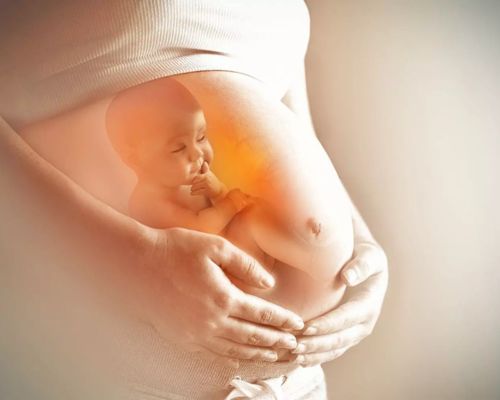
जब तक सन्तान माँ के गर्भ में रहती है तब तक उसके शरीर तथा मन को अपनी इच्छानुसार ढाला जा सकता है। यह समय ऐसा है, मानो माँ के हाथ में दे दिया गया है कि अपनी सन्तान को जैसा चाहे बना डाले। जो माताएँ सन्तान के जन्म लेने के बाद उसके बिगड़ जाने को देखकर रोया करती हैं, उन्हें समझ लेना चाहिये कि यह कष्ट उन्हें इसीलिये झेलना पड़ता है, क्योंकि जो समय बच्चे को ढालने का था उसे उन्होंने खो दिया। जब कोई वस्तु ढल रही हो, तभी तो उसे पहले से बनी रूप-रेखा के अनुसार ढाला जा सकता है, जब वह ढल गई तब उसे नई दिशा देना कठिन हो जाता है। माँ के पेट में जो सन्तान है उसका दो दिशाओं में निर्माण होना है। एक दिशा है-उसका शारीरिक विकास; दूसरी दिशा है-उसका मानसिक विकास। शारीरिक- विकास के लिये पुंसवन-संस्कार का विधान है, मानसिक विकास के लिये सीमन्तोन्नयन-संस्कार का विधान है। हम इस प्रकरण में पुंसवन-संस्कार पर लिख रहे हैं, सीमन्तोन्नयन-संस्कार पर अगले अध्याय में लिखेंगे। पुंसवन-संस्कार का मुख्य लक्ष्य माता का ध्यान उसके गर्भ में पल रही सन्तान के शारीरिक-विकास की तरफ खींचना है। इसलिये यह संस्कार गर्भाधान के बाद यह निश्चय हो जाने पर कि गर्भ स्थिर हो गया है किया जाता है। यह निश्चय गर्भाधान क्रिया के दूसरे या तीसरे महीने हो जाता है। गर्भस्थित होने के बाद गर्भस्थ सन्तान को दो प्रकार के खतरे हो सकते हैं। एक खतरा तो यह है कि माता की असावधानी से स्थित हुआ गर्भ ही गिर जाए, दूसरा खतरा यह है कि गर्भ तो बना रहे परन्तु स्वास्थ्य के नियमों का पालन न करने से सन्तान का शरीर ठीक तरह से विकसित तथा पुष्ट न हो पाये। इन सब बातों को ध्यान में रखते हुए माता- पिता के लिये यह जानना आवश्यक है
As long as the child remains in the mother's womb, his body and mind can be molded as per his wish. This time is as if it has been handed over to the mother to make her child whatever she wants. Those mothers who cry after seeing the deterioration of their child after birth, they should understand that they have to suffer this pain because they lost the time which was there to mold the child. Only when an object is being molded can it be molded according to the outline already made; once it has been molded, it becomes difficult to give it a new direction. The child in the mother's womb has to be formed in two directions. One direction is his physical development; The second direction is his mental development. For physical development, there is the ritual of Punsavana Sanskar, for mental development there is the ritual of Seemantonnaya Sanskar. We are writing on Punsavan Sanskar in this episode, we will write on Seemantonnayan Sanskar in the next chapter. The main objective of Punsavan Sanskar is to keep the mother's attention on the growing child in her womb. To pull towards the physical development of the child. Therefore, this sanskar is performed after conception when it is confirmed that the pregnancy has become stable. This determination takes place in the second or third month after conception. After conception, there can be two types of dangers to the fetus. One danger is that due to the carelessness of the mother, the fetus may miscarry; the other danger is that the pregnancy may persist but due to not following the health rules, the child's body may not be able to develop properly and become strong. Keeping all these things in mind, it is important for parents to know

संस्कारविधि में लिखा है कि सीमन्तोन्नयन संस्कार में पति अपने हाथ से स्वपत्नी के केशों में सुगन्धित तेल डाले, कंघी से सुधारे, पट्टी निकाले, जूड़ा सुन्दर बाँध कर दोनों यज्ञशाला में आयें। इसका अभिप्राय यही है कि इस समय पति तथा पत्नी दोनों का ध्यान अपने तथा सन्तान के मानसिक विकास पर केन्द्रित हो जाना चाहिये, उन्हें यह समझ लेना चाहिये कि सन्तान का मानसिक विकास उनके अपने ऊपर निर्भर करेगा, जैसा मानसिक-जीवन वे व्यतीत करेंगे उसी की छाप उनकी सन्तान पर पड़ेगी। शास्त्रकारों ने माता को एक ऐसा सांचा माना था, जिसमें माता-पिता जैसी सन्तान चाहते उसे वैसा ढाल सकते हैं। इस समय को अगर हाथ से खो दिया, तो सन्तान के जन्म लेने के बाद बाहर की अच्छी या बुरी परिस्थिति का प्रभाव प्रबल रूप धारण कर लेता है।
It is written in the rituals that in the Seemantonnaya ceremony, the husband applies fragrant oil to his wife's hair with his own hands, combs it with a comb, removes the bandage, ties a beautiful bun and both of them come to the Yagyashala. The meaning of this is that at this time, the attention of both husband and wife should be focused on the mental development of themselves and their children, they should understand that the mental development of their children will depend on themselves, the mental life they lead will depend on them. The impression will be on their children. The scripture writers had considered mother as a mold in which parents can mold their child as per their wish. If this time is missed, then after the birth of the child, the influence of good or bad external circumstances becomes stronger.

गर्भाधान, सीमन्तोन्नयन तथा पुंसवन संस्कार तब किये जाते हैं जब सन्तान माता के पेट में होती है, अब आगे हम जिन संस्कारों का वर्णन करेंगे वे तब किये जाते हैं जब सन्तान जन्म लेकर संसार में प्रवेश कर जाती है। पहले तीन संस्कारों को 'जन्म-पूर्व' (Prenatal) कहा जा सकता है, अगले संस्कारों को 'जन्मोत्तर' (Post-natal) संस्कार कहा जा सकता है। 'जन्म-पूर्व-संस्कारों' पर माता तथा आनुवंशिक (Hereditary) संस्कारों का मुख्य प्रभाव पड़ता है, 'जन्मोत्तर- संस्कारों' पर पर्यावरण-सम्बन्धी (Environmental) संस्कारों का मुख्य प्रभाव पड़ता है। क्योंकि संस्कारों का उद्देश्य सन्तान को सुसंस्कृत करना है, जन्म- जन्मान्तर के मल को धो डालकर उसका नव-निर्माण करना है, इसलिये 'जन्म- : पूर्व' तथा 'जन्मोत्तर' दोनों दशाओं को संस्कार-पद्धति में सुधारने का प्रयत्न किया जाता है। सन्तान के उत्पन्न हो जाने के बाद जो कर्म किये जायें, वे जात-कर्म कहलाते हैं। इसे संस्कार का नाम इसलिये दिया गया है, क्योंकि उत्पन्न होने के बाद किये जानेवाले 'कर्मों' के अतिरिक्त इसमें कुछ 'संस्कार' भी किये जाते हैं, जिनका उद्देश्य सन्तान के अनजाने भी उस पर कुछ संस्कार डालने का प्रयत्न किया जाता है। हम पहले उन कर्मों का जिक्र करेंगे जो सन्तान के उत्पन्न होने पर करना आवश्यक हैं, फिर उन संस्कारों का जिक्र करेंगे जो माता-पिता या समाज द्वारा जन्म के प्रारम्भिक दिनों में सन्तान पर डालने का यत्न किया जाता है। गर्भावस्था में बच्चा-एक अलग ही पर्यावरण में होता है। वह मुख से भोजन नहीं लेता, नाक से सांस नहीं लेता। उसका भोजन नाभि द्वारा माता से सीधा पहुँचाता है। गर्भावस्था में वह एक थैली में बन्द होता है, जिसमें पानी भरा होता है। यह पानी मुख या नाक में न चला जाए, इसलिये प्रकृति ने उनका मुख तथा नाक श्लेष्मा से बन्द कर दिया होता है। वाह्य-जगत् में आने के बाद उसका मुख तथा नाक साफ करना होता है। अब क्योंकि उसका माता से शारीरिक सम्बन्ध टूट जाता है, इसलिये माता से पोषण-तत्व अनायास नहीं प्राप्त होता। मुख साफ करने के बाद वह दूध पी सकता है, नाक साफ करने के बाद वह साँस ले सकता है।
Garbhadhaan, Semantonnayan and Punsavan rituals are performed when the child is in the mother's womb, now the rituals which we will describe further are performed when the child is born and enters the world. The first three rites can be called 'prenatal', the next rites can be called 'post-natal' rites. Mother's and hereditary values have the main influence on 'pre-birth values'; environmental values have the main influence on 'post-birth values'. Because the purpose of the sanskars is to make the child cultured, to wash away the waste of birth after birth and to create a new one, hence efforts are made to improve both the 'before' and 'after birth' conditions in the sanskar system.
The actions that are performed after the birth of a child are called caste actions. It has been given the name of sanskar because apart from the 'karmas' that are done after birth, some 'sanskars' are also done in it, the purpose of which is to try to impart some sanskar on the child even without his knowledge. We will first mention those actions which are necessary to be performed when the child is born, then we will mention those values which the parents or the society try to impart on the child in the initial days of birth. .During pregnancy, the child is in a different environment. He does not take food through the mouth, does not breathe through the nose. Its food is delivered directly from the mother through the navel. During pregnancy, it is enclosed in a sac which is filled with water. To prevent this water from entering the mouth or nose, nature has closed their mouth and nose with mucus. After coming into the outside world, one's mouth and nose have to be cleaned. Now because his physical relationship with his mother is broken, he does not get the nutrients from his mother naturally. After cleaning his mouth he can drink milk, after cleaning his nose he can breathe.

यह परंपरा लड़के का नाम ग्यारहवें या पहले वर्ष या दूसरे वर्ष की शुरुआत से एक ही अर्थ में रखने पर आधारित है, यदि लड़के का नाम एक ही अक्षर से रखा गया है और यदि लड़की का नाम अंतिम अक्षर से रखा गया है।
This tradition is based on keeping the name of the boy with the same meaning from the eleventh or the first year or the beginning of the second year, if the boy is named with the same letter and if the girl is named with the last letter

निष्क्रमण-संस्कार छठा संस्कार है। 'निष्क्रमण' का अर्थ है- बाहर निकलना। अबतक बच्चा घर की चार दीवारी में बन्द था, परन्तु घर के बन्द वातावरण में ही उसे नहीं पड़े रहना है, उससे बाहर निकलना है। शरीर तथा मन के विकास के लिये ठण्डी हवा तथा सूर्य की रोशनी की जितनी आवश्यकता है उतना दूसरी किसी वस्तु की नहीं। इसी उद्देश्य को सम्मुख रख कर बच्चे के लिये एक धार्मिक- संस्कार का विधान कर दिया गया है ताकि वह ठण्डी ताजी हवा तथा सूर्य की प्राणप्रद किरणों का सेवन कर सके। अभी वह इस योग्य तो हुआ नहीं होता कि स्वयं दौड़ता-धूपता फिरे, इसलिये इस बात को माता-पिता के धार्मिक कर्त्तव्य में जोड़ दिया गया है कि वे उसे घर की चार दीवारी में से निकालें और उसे शुद्ध वायु तथा धूप का सेवन करायें। सूर्य की रोशनी तथा ताजी हवा का महत्त्व संसार में जितनी भी 'शक्ति' (Energy) है उसका उद्गम सूर्य से है। अगर सूर्य के प्रकाश, उसकी किरणों का विश्व में प्रसार न हो, तो स्वस्थ रहना असम्भव है। सूर्य ही जीवनी-शक्ति का भण्डार है, उसका स्थान अन्य कोई वस्तु नहीं ले सकती, क्योंकि सूर्य ही वह स्रोत है जहाँ से विश्व के कण-कण में शक्ति प्रवाहित हो रही है। इसलिये अगर हमें सन्तान के जीवन को बनाये रखना या उसे दीर्घजीवी बनाना है, तो हमें उसे ज्यादा-से-ज्यादा समय के लिये सूर्य के प्रकाश में उतनी देर तक रखना चाहिये जितना रख सकें। सूर्य की जीवनदायिनी किरणों से ताजी हवा में जीवनी-शक्ति का संचार हो जाता है, इसलिये स्वास्थ्य तथा दीर्घजीवन के लिये शुद्ध, स्वच्छ हवा में माता तथा बच्चे का जितनी देर तक हो सके साँस लेना उपयोगी है। इस बात को कभी नहीं भुलाना चाहिये कि सब प्रकार का जीवन 'सौर- शक्ति' (Solar energy) पर आश्रित है। सूर्य ही वह डायनेमो है जिससे जीवनी- शक्ति उत्पन्न होती है। वनस्पति तथा प्राणी का जीवन सौर-शक्ति से बना रहता है। अगर वनस्पति को या प्राणी को सूर्य से शक्ति प्राप्त न हो, तो जीवन नहीं रह सकता। तो भी हम लोग इस प्रकार का कृत्रिम-जीवन बिता रहे हैं, जिसमें असंख्य व्यक्ति सूर्य के प्रकाश से वंचित रहते हैं, मानो सूर्य की जीवनीदायिनी शक्ति जो वनस्पति, पशु पक्षी के जीवन के लिये अत्यावश्यक है | निष्क्रमण-संस्कार छठा संस्कार है। 'निष्क्रमण' का अर्थ है- बाहर निकलना। अबतक बच्चा घर की चार दोवारी में बन्द था, परन्तु घर के बन्द वातावरण में ही उसे नहीं पड़े रहना है, उससे बाहर निकलना है। शरीर तथा मन के विकास के लिये ठण्डी हवा तथा सूर्य की रोशनी की जितनी आवश्यकता है उतना दूसरी किसी वस्तु की नहीं। इसी उद्देश्य को सम्मुख रख कर बच्चे के लिये एक धार्मिक- संस्कार का विधान कर दिया गया है ताकि वह ठण्डी ताजी हवा तथा सूर्य की प्राणप्रद किरणों का सेवन कर सके। अभी वह इस योग्य तो हुआ नहीं होता कि स्वयं दौड़ता-धूपता फिरे, इसलिये इस बात को माता-पिता के धार्मिक कर्त्तव्य में जोड़ दिया गया है कि वे उसे घर की चार दीवारी में से निकालें और उसे शुद्ध वायु तथा धूप का सेवन करायें।
Nishkraman Sanskar is the sixth Sanskar. 'Niskraman' means to come out. Till now the child was confined within the four walls of the house, but he does not have to stay in the closed environment of the house, he has to come out of it. For the development of body and mind, nothing else is as necessary as cool air and sunlight. Keeping this objective in mind, a religious ritual has been prescribed for the child so that he can enjoy cool, fresh air and the vitalizing rays of the sun. He is not yet capable of running around on his own, hence it has been added to the religious duty of the parents to take him out of the four walls of the house and provide him with pure air and sunlight. Importance of sunlight and fresh air All the energy in the world originates from the Sun. If sunlight and its rays do not spread in the world, then it is impossible to remain healthy. Sun is the storehouse of life force, nothing else can take its place, because Sun is the source from where power is flowing in every particle of the world. Therefore, if we want to maintain the life of the child or make him long-lived, then we should keep him in sunlight for as long as we can. Life-giving energy is infused in fresh air by the life-giving rays of the Sun, therefore, for health and longevity, it is beneficial for the mother and child to breathe in pure, clean air for as long as possible. It should never be forgotten that all forms of life are dependent on 'solar energy'. Sun is the dynamo from which life force is generated. The life of plants and animals depends on solar power. If plants or animals do not get energy from the Sun, life cannot exist. Yet we are living such an artificial life, in which countless people are deprived of sunlight, as if the life-giving power of the Sun which is essential for the life of plants, animals and birds, .Nishkraman Sanskar is the sixth Sanskar. 'Niskraman' means to come out. Till now the child was confined within the four doors of the house, but he does not have to stay in the closed environment of the house, he has to come out of it. For the development of body and mind, nothing else is as necessary as cool air and sunlight. Keeping this objective in mind, a religious ritual has been prescribed for the child so that he can enjoy cool, fresh air and the vitalizing rays of the sun. He is not yet capable enough to run around on his own, hence it has been added to the religious duty of the parents to take him out of the four walls of the house and provide him with pure air and sunlight.
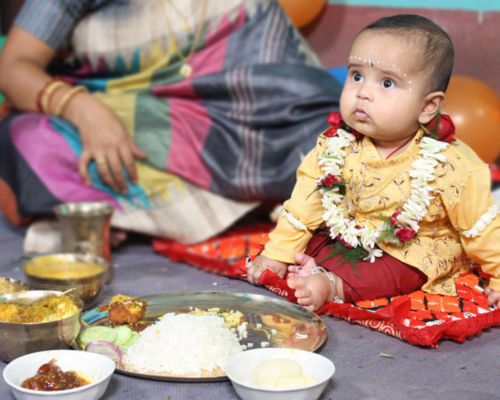
अन्नप्राशन का अर्थ है-जीवन में पहले-पहल अन्न का खाना। बच्चे को जन्मते ही माँ का दूध मिलता है, उस समय न तो अन्न चबाने के लिये उसके दाँत होते हैं, न अन्न हज्म करने लायक उसका हाजमा होता है। उस समय जो भोजन उसके लिये सम्भव हो सकता है उसका प्रबन्ध परमात्मा ने उसके लिये कर दिया है। इतना ही नहीं कि उसका उसने प्रबन्ध कर दिया है, परन्तु प्रभु की ऐसी रचना है कि उस भोजन को ढूँढ़ने के लिये उसे कहीं नहीं जाना पड़ता। जहाँ उसने आँखें खोलीं, न भी खोलीं, जहाँ उसने जीवन का साँस लिया वहीं उसे जीवन धारण का साधन माँ के दूध में अनायास मिल गया। अब प्रश्न यह रह जाता है कि माँ के तथा बच्चे के स्वास्थ्य की दृष्टि से कबतक उसे दूध पर इस प्रकार निर्भर रहना चाहिये ताकि माँ का स्वास्थ्य भी बना रहे, बच्चे का पोषण भी चलता रहे
Annaprashan means eating food for the first time in life. A child receives mother's milk as soon as he is born, at that time he neither has teeth to chew food nor does he have the digestion to digest food. God has made arrangements for whatever food is possible for him at that time. Not only that he has made arrangements for it, but God's creation is such that he does not have to go anywhere to find that food. Wherever he opened his eyes or did not open them, wherever he took the breath of life, he spontaneously found the means of sustaining life in his mother's milk. Now the question remains that from the point of view of the health of the mother and the child, for how long should she depend on milk in such a way that the health of the mother is maintained and the nutrition of the child also continues.
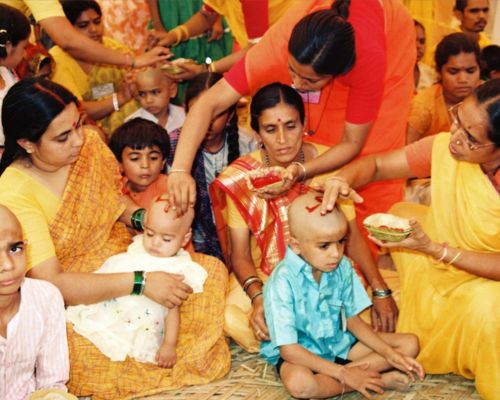
चूड़ाकर्म संस्कार संस्कारों की श्रृंखला में आठवाँ संस्कार है। इसके लिये अन्य शब्दों का भी प्रयोग किया जाता है। उदाहरणार्थ, इसे मुण्डन-संस्कार, चूड़ाकरण, केश-वपन, क्षौर आदि भी कहते हैं।
संस्कृत में 'चूड़ा' शब्द शिखर या चोटी के लिये प्रयुक्त होता है। अस्ताचलचूड़ावलम्बिनी कुमुदनी' में 'चूड़ा'- शब्द का अस्ताचल के शिखर से अभिप्राय है। इस दृष्टि से चूड़ाकर्म का अर्थ है- सिर के बालों के सम्बन्ध में कर्म। हिन्दी का 'जूड़ा' शब्द 'चूड़ा' का अपभ्रंश है।
आश्वलायन गृह्यसूत्र में लिखा है-'तृतीये वर्षे चौलम्'
तीसरे वर्ष में चूड़ाकर्म-संस्कार करना चाहिये।
पारस्कर गृह्यसूत्र में लिखा है'
सांवत्सरिकस्य चूड़ाकरणम्'
एक वर्ष का बालक हो जाए, तो उसका चूड़ा-संस्कार कर दे। इसका अभिप्राय यह है कि मुण्डन-संस्कार जन्म से तीसरे वर्ष या एक वर्ष के भीतर कर देना चाहिये। वैज्ञानिक दृष्टि से तीसरे साल करना अधिक युक्तियुक्त है,शरीर में वैसे तो सब अंग अपने-अपने काम की दृष्टि से मुख्य हैं, परन्तु मस्तिष्क का सबसे मुख्य स्थान है। मस्तिष्क दो भागों में बँटा हुआ है-'बृहत्- मस्तिष्क' (Cerebrum) तथा 'लघुमस्तिष्क' (Cerebellum)। मस्तिष्क के ये दोनों भाग ज्ञान और क्रिया के केन्द्र हैं। इसी से पाँचों ज्ञानेन्द्रियों तथा पाँचों कर्मेन्द्रियों का सञ्चालन होता है। यह सारी मशीनरी खोपड़ी के भीतर रहती है। मस्तिष्क को ढकनोली खोपड़ी के कई भाग हैं जो बचपन में ठीक प्रकार से जुड़े नहीं होते। इन भागों के जुड़ने को अस्थि-सन्धि कहते हैं। खोपड़ी की अस्थियों की सन्धियाँ तीन साल से पहले नहीं जुड़तीं, इसलिये गर्भावस्था में ही शिशु के सिर पर बाल होते हैं ताकि शिशु की खोपड़ी की वे रक्षा करते रहें, और खोपड़ी के भीतर का मस्तिष्क सुरक्षित रहे । तीन साल के बाद खोपड़ी की अस्थियाँ जुड़ जाती हैं, इसलिये गर्भावस्था के बालों को निकाल देने का समय आ जाता है। गर्भावस्था के बालों को, जो अब तक खोपड़ी की, और खोपड़ी की रक्षा द्वारा मस्तिष्क की रक्षा कर रहे थे उस्तरे से निकाल देने के निम्न कारण हैं- मलिन बालों को निकाल देना-शिशु जब गर्भ में होता है तभी उसके बाल आ जाते हैं और वे मलिन जल में रहते हैं। इन मलिन केशों को उस्तरे से साफ कर देना आवश्यक है-इसी कारण मुण्डन किया जाता है। इन केशों को तभी
तक रखना उचित है जब तक खोपड़ी की सन्धि-अस्थियाँ आपस में न जुड़ें। क्योंकि तीसरे साल तक ये जुड़ जाती हैं, इसलिए इसके बाद इन मलिन केशों को रखने से कोई लाभ नहीं है। चूड़ाकर्म का दाँतों के निकलने से सम्बन्ध है चूड़ाकर्म के लिये सूत्र-ग्रन्थों ने दो समय दिये हैं-या तो जन्म के प्रथम वर्ष, या तीसरे वर्ष। प्रथम तथा तृतीय वर्ष का कारण यह है कि बच्चे के ६-७ मास की आयु से दाँत निकलने शुरु हो जाते हैं जो अढ़ाई-तीन वर्ष की आयु तक निकलते रहते हैं। बच्चे के दाँत दो बार निकलते हैं- पहले दूध के दाँत कहलाते हैं, इनके टूटने के बाद स्थिर, पक्के दाँत निकलते हैं। दूध के दाँत २० होते हैं, इनके • बाद पक्के दाँत ३२ होते हैं। एक वर्ष की आयु तक पहुँचते-पहुँचते आठ दाँत • निकल आते हैं-चार ऊपर के, चार नीचे के। डेढ़ वर्ष की आयु में १२ दाँत, डेढ़ से दो वर्ष की आयु में १६ दाँत और दो से अढ़ाई-तीन वर्ष की आयु तक पहुँचते- पहुँचते २० दाँत निकल आते हैं। दाँत अन्तर देकर निकलते हैं, पहले नीचे के दाँत निकलते हैं, इनके निकलने के बाद प्रकृति ने आराम देने के लिये अगले दाँत निकलने में व्यवधान डाल दिया है ताकि शिशु को लगातार कष्ट न उठाना पड़े। दाँत निकलते समय सिर भारी हो जाता है, गर्म रहता है, सिर में दर्द होता है, मसूड़े सूज जाते हैं, लार बहा करती है, दस्त लग जाते हैं, हरे-पीले पनीले भारी- भारी दस्त आते हैं, आँखें आ जाती हैं, बच्चा चिड़चिड़ा हो जाता है। दाँतों का भारी प्रभाव सिर पर पड़ता है, इसलिये सिर को हल्का तथा ठण्डा रखने के लिये सिर पर से बालों का बोझ उतार डालना ही चूड़ाकर्म-संस्कार का उद्देश्य है। दाँत निकलते समय बच्चे को जो कष्ट होते हैं-हरे-पीले दस्त, आँख आ जाना, चिड़चिड़ापन आदि-इनके लिये होम्योपैथी की औषधि कैमोमिला ३० शक्ति बहुत उपयोगी है। जब हरे-पीले दस्त आने लगें तब इस औषधि की छोटी- छोटी ३-४ गोलियाँ उसके मुख में डाल देने से दस्तों को लाभ होता है, चिड़चिड़ापन जाता रहता है, नींद भी आ जाती है, बच्चा परेशान नहीं करता
In Hindi, the word 'Chuda' means the peak of Astachal. From this point of view, Chudakarma means actions related to the hair on the head. The Hindi word 'Juda' is a corruption of 'Chura'.
It is written in Ashvalayana Grihyasutra
Chudakarma-sanskaar should be performed in the third year.
It is written in Paraskar Grihya Sutra,
When a child is one year old, perform his chooda rites. What this means is that the Mundan Sanskar should be performed within the third year or one year after birth. From a scientific point of view, it is more logical to do it in the third year. Although all the organs in the body are important in terms of their respective functions, but the brain has the most important place. The brain is divided into two parts – 'Cerebrum' and 'Cerebellum'. Both these parts of the brain are centers of knowledge and action. Through this the five sense organs and the five action senses operate. All this machinery resides within the skull. There are many parts of the skull covering the brain that do not connect properly during childhood. The joining of these parts is called bone joint. The joints of the bones of the skull do not join before the age of three, so the baby has hair on his head during pregnancy itself so that they continue to protect the baby's skull, and the brain inside the skull remains safe. After three years the bones of the skull fuse, so it is time to remove pregnancy hair. The following are the reasons for removing pregnancy hair, which till now was protecting the scalp and the brain by protecting the skull, with a razor - Removing dirty hair – When the baby is in the womb, his hair starts growing and they live in dirty water. It is necessary to clean these dirty hair with a razor - this is why shaving is done. It is appropriate to keep these hairs only until the joint bones of the skull join together. Since they grow together by the third year, there is no benefit in keeping these gray hairs after that.
Chudakarma is related to the eruption of teeth. The sutra texts have given two times for Chudakarma - either before birth or year, or third year. The reason for the first and third year is that the child's teeth start erupting from the age of 6-7 months and they continue to erupt till the age of two and a half to three years. Child's teeth emerge twice - first are called milk teeth, after their fall, stable, permanent teeth emerge. There are 20 milk teeth, followed by 32 permanent teeth. By the time one reaches the age of one year, eight teeth emerge – four on top, four on the bottom. 12 teeth at the age of one and a half years, 16 teeth at the age of one and a half to two years and 16 teeth at the age of two and a half to three years - By then 20 teeth emerge. Teeth emerge with a gap, the lower teeth emerge first, after these emerge, nature has disrupted the eruption of the next teeth to give rest so that the child does not have to suffer continuously. At the time of teething, the head becomes heavy, hot, there is headache, gums swell, drooling, loose motions, greenish-yellow watery loose motions, conjunctivitis, The child becomes irritable. Teeth have a heavy impact on the head, hence the purpose of Chudakarma Sanskar is to remove the burden of hair from the head to keep the head light and cool. Homeopathic medicine Chamomilla 30 potency is very useful for the problems faced by the child during teething - greenish-yellow diarrhea, conjunctivitis, irritability etc. When greenish yellow diarrhea starts, putting 3-4 small tablets of this medicine in the child's mouth provides relief from diarrhoea, irritability goes away, sleep also comes and the child does not get disturbed.
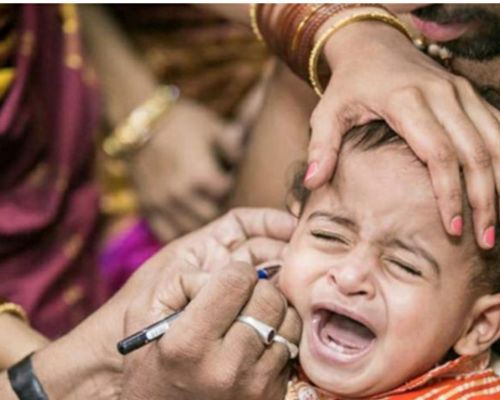
[ अथ कर्णवेधो वर्षे तृतीये पंचमेवा वा ]
संस्कारों की श्रृंखला में कर्णवेध नवाँ संस्कार है। कर्णवेध का अर्थ है- कान को बींध देना, उसमें छेद कर देना। ऐसा प्रतीत होता है कि किसी समय भारत में कान बींधने का काफी प्रचलन था, इसीलिये इसे संस्कारों की श्रेणी में रखा गया। आजकल बहुत कम लोग हैं जो अपने बच्चों का यह संस्कार करते हैं। अब इसका संस्कार का रूप नहीं रहा, जिन्होंने कर्णवेध करवाना होता है वे सुनार या किसी दक्ष व्यक्तित्व को बुलाकर कान छिदवा देते हैं। लड़कों की जगह लड़कियों का कान तथा नाक प्रायः ये दोनों छिदवा दिये जाते हैं, क्योंकि कान तथा नाक में आभूषण पहनने की प्रथा लड़कियों तथा स्त्रियों में अधिक प्रचलित है। प्राचीनकाल में तो बड़े-बूढ़े भी कानों में बालियाँ पहना करते थे, परन्तु अब पुरुषों ने इसे त्याग दिया है, कन्याएँ इसे नहीं त्याग सकीं। पं० गंगाप्रसाद जी 'संस्कार-प्रकाश' में लिखते हैं कि" स्त्रियों से आशा करना व्यर्थ है कि वे आभूषणों के प्रेम को त्याग सकेंगी। कन्याएँ आभूषणों के लिये सब प्रकार की असुविधाएँ सहन कर सकती हैं। मेरी पुत्री जब छोटी थी तब मैं कहा करता था कि तू अपनी नाक न छिदवाना। नाक पशुओं की छेदी जाती है, जिससे उनकी नाक में 'नथ' डाली जा सके, परन्तु मेरे आदेश और मेरी युक्तियाँ का उसपर कोई प्रभाव न पड़ा। उसने चुपके से अपनी नाक छिदवा ली।"
Karnavedha is the ninth rite in the series of rites. Karnavedha means to pierce the ear, to make a hole in it. It seems that at one time ear piercing was quite prevalent in India, that is why it was kept in the category of rituals. Nowadays, there are very few people who perform this ritual for their children. Now it is no longer a ritual, those who want to get their ears pierced call a goldsmith or some skilled person and get their ears pierced. Instead of boys, girls' ears and nose are often pierced because the practice of wearing jewelery in ears and nose is more prevalent among girls and women. In ancient times, even elders used to wear earrings in their ears, but now men have abandoned it, girls could not abandon it. Pt. Gangaprasad ji writes in 'Sanskar-Prakash' that "It is futile to expect women to give up their love for jewellery. Girls can bear all kinds of inconveniences for the sake of jewellery. When my daughter was young, I used to say It was told that you should not get your nose pierced. The nose of animals is pierced so that 'Nath' can be inserted in their nose, but my orders and my advice had no effect on him. He got his nose pierced secretly."
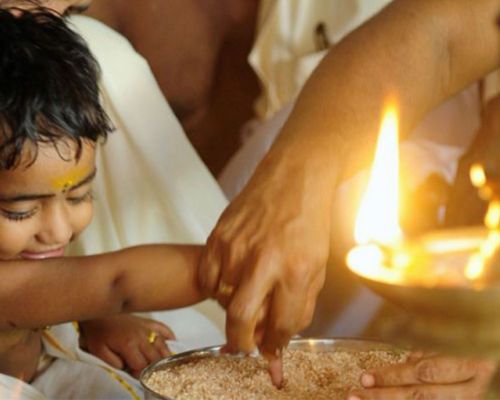
जैसा हम उपनयन-संस्कार पर लिखते हुए कह आये हैं, उपनयन तथा वेदारम्भ संस्कारत एक-दूसरे से इतने जुड़े हुए हैं कि इन दोनों में भेद करना कठिन है। ऋषि दयानन्द संस्कारविधि में लिखते हैं कि जो दिन उपनयन-संस्कार का है, वही दिन वेदारम्भ का है। यदि वेदारम्भ उसी दिन न हो सके तो दूसरे दिन कर ले। यदि दूसरा दिन भी अनुकूल न हो तो एक वर्ष के भीतर किसी दिन करें। अगर उपनयन-संस्कार करने के पश्चात् उसी दिन वेदारम्भ करना हो, तो वेदारम्भ में ईश्वरस्तुतिप्रार्थनोपासना, स्वस्तिवाचन, शान्तिकरण से लेकर सामान्य प्रकरण के अन्त तक की यज्ञ-सम्बन्धी प्रक्रिया को दोबारा दोहराने की आवश्यकता नहीं। अन्यथा, वेदारम्भ-संस्कार के विधि-भाग में हम जो प्रक्रिया लिख रहे हैं, उसके अनुसार यज्ञ करें
As we have said while writing on Upanayana-Sanskar, Upanayana and Vedarambh Sanskar are so connected to each other that it is difficult to differentiate between them. Rishi Dayanand writes in Sanskarvidhi that the day of Upanayana-Sanskar is the same day of Vedarambh. If Vedarambh cannot be done on the same day, then do it on another day. If the second day is also not favourable, then do it some day within a year. If Veda start is to be started on the same day after performing the Upanayana Sanskar, then there is no need to repeat the Yagya related process from the beginning of Veda starting with praise of God, reciting Swastiva, peace making till the end of the general episode. Otherwise, perform the Yagya as per the procedure we are writing in the method section of Vedarambh-Sanskar.
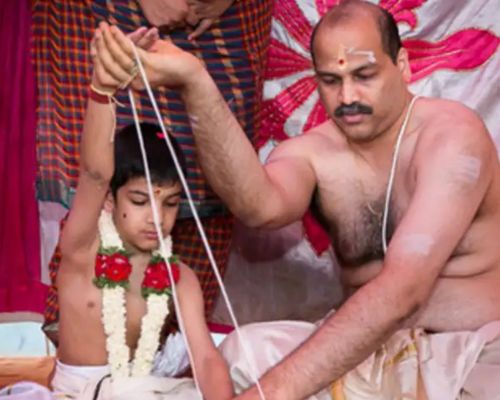
उपनयन' का शब्दार्थ है-उप-समीप, 'नयन' ले जाना। विद्याध्ययन के लिये गुरु या आचार्य के समीप ले जाने को उपनयन कहा जाता है। उपनयन का अर्थ है-गुरु के समीप हो जाना।
'द्विज' का अर्थ है- जिसका दूसरा जन्म हो। माता-पिता से तो पहला जन्म होता है, परन्तु इस जन्म के बाद जब बालक संस्कृति की भट्टी में पड़ कर नवीन- मानव होने की प्रक्रिया में पड़ जाता है, तब उसे बालक का दूसरा जन्म कहा जाता है। मनुस्मृति में कहा है- 'जन्मना जायते शूद्रःसंस्कारात् द्विज उच्यते
जन्म से तो सभी शूद्र पैदा होते हैं, संस्कारों से ही मनुष्य 'द्विज' बनता है। संस्कारों के बिना मनुष्य मनुष्य नहीं बन सकता। क्या हम देखते नहीं कि आयुर्वेद में संखिया जैसे विष को संस्कारों की भावना देकर मृततुल्य बना दिया जाता है, जंगली खूंखार शेर को संस्कारों द्वारा बकरी के साथ एक घाट पानी पिला दिया जाता है। उपनयन संस्कार का अभिप्राय यह है कि अब तक माता-पिता अपने परिश्रम से बालके के जीवन पर ऐसे संस्कार डाल रहे थे जिनसे वह इस जन्म के संस्कारों के कारण नव-मानव बन सके, अब वे उसे आचार्य के पास लानेका श्रीगणेश करने वाले हैं, जिससे आचार्य, जिसका काम ही बच्चों को नया जीवन देना है, उन्हें नये साँचे में ढालना है, बच्चे के जीवन को उसकी प्रवृत्तियों के अनुसार एक नई दिशा दे सके।
यज्ञोपवीत बाहर कपड़ों पर धारण किया जाता है बच्चे को जीवन की नई दिशा दी जाए, वह कुछ बन सके- यह किस माता- पिता की इच्छा नहीं होती। वैदिक-संस्कृति में उपनयन संस्कार माता-पिता द्वारा इस बात की घोषणा थी कि अब हमने तो इस बालक को भौतिक-जीवन दे दिया, इस पर बाल्यावस्था में जो सुसंस्कार डालने हमारे बस में थे उन्हें डालने का हमने यत्न किया, परन्तु अब हम इस बालक को समाज के उन विशेषज्ञों के हाथ में दे देना चाहते हैं जो इस विज्ञान के धुरंधर पंडित हैं। यज्ञोपवीत में तीन धागों का एक सूत्र बालक के शरीर पर डाला जाता था- इन्हीं तीन तारों वाले सूत्र को 'यज्ञ-सूत्र' या 'यज्ञोपवीत' कहा जाता था। इसे धारण कर लेने का अभिप्राय यह था कि अब यह बालक पढ़ने-लिखने लगा है। जैसे आजकल स्कूल में भर्ती होते हुए वहाँ दाखिला लेते हैं, उसका नाम रजिस्टर में लिखा जाता है, वैसे ही किसी समय विद्याभ्यास करना शुरु करने का चिह्न यज्ञोपवीत था। जिस देश में यह संस्कार प्रचलित था उस देश में अपठित व्यक्ति कौन रह सकता था। हर व्यक्ति को पाँच,छः वार्ष की आयु मे यज्ञोपवीत संस्कार करना पड़ता था
उपनयन तथा वेदारम्भ संस्कार आपस में इतने निकट हैं कि इनका एक- दूसरे से भेद न करना ही ठीक है, परन्तु क्योंकि आज के समाज में उपनयन तो प्रायः सभी करते हैं, उपनयन के साथ वेदारम्भ संस्कार सिर्फ गुरुकुलों में किया जाता है, इसलिये हम यहाँ इन दोनों संस्कारों का अलग-अलग वर्णन करेंगे।
उपनयन संस्कार इसलिये किया जाता है कि अब इसके बाद बालक या बालिका वेद का अध्ययन प्रारम्भ करेंगे, वेद के अध्ययन का अभिप्राय आजकल की परिभाषा में शिक्षा का प्रारम्भ करना है। उपनयन संस्कार शिक्षा के मन्दिर में प्रवेश करने का द्वार है, इस द्वार में प्रविष्ट होकर विद्या का जो अध्ययन किया जाता है वह वेदारम्भ-संस्कार कहाता है।
The meaning of 'Upanayan' is - to take 'up-close', 'Nayan'. Taking one near a Guru or Acharya for study is called Upanayan. Upanayana means to become close to the Guru.
'Dwij' means one who has second birth. The first birth takes place from the parents, but after this birth, when the child gets immersed in the furnace of culture and gets involved in the process of becoming a new human being, then it is called the second birth of the child. It is said in Manusmriti
Everyone is born a Shudra by birth, it is only through the sanskars that a person becomes a 'Dwija'. Without values, a human being cannot become a human being. Don't we see that in Ayurveda, a poison like Sankhia is made dead by giving it the spirit of rituals, a wild ferocious lion is given a ghat of water to drink along with a goat through rituals. The meaning of Upanayana Sanskar is that till now the parents with their hard work were imparting such values in the life of the child by which he can become a new human being due to the sanskars of this birth, now they are going to initiate him to bring him to Acharya. So that the teacher, whose job is to give new life to the children and mold them in a new mold, can give a new direction to the child's life according to his tendencies.
Yagyopavit is worn outside on clothes. The child should be given a new direction in life, so that he can become something - which mother- Father does not wish. In the Vedic culture, Upanayana Sanskar was a declaration by the parents that now we have given physical life to this child, we tried to instill in him the good values which were within our control during childhood, but now we They want to hand over the child to the experts of the society who are experts in this science. In Yajnopaveet, a thread of three threads was put on the child's body - this thread with these three strings was called 'Yajna-sutra' or 'Yagnopaveet'. The meaning of wearing it was that now this child has started reading and writing. Just like nowadays, when one gets enrolled in a school, his name is written in the register, in the same way, once upon a time, the symbol of starting the study was Yagyopavit. How could an illiterate person live in a country where this culture was prevalent? Every person had to perform the Yagyopavit Sanskar at the age of five or six years.
Upanayan and Vedarambh Sanskar are so close to each other that it is better not to differentiate them from each other, but because in today's society almost everyone does Upanayan, Vedarambh Sanskar along with Upanayan is done only in Gurukuls, that is why we here We will describe both these rituals separately. Upanayana Sanskar is performed because after this the boy or girl will start studying the Vedas, the meaning of studying Vedas in today's definition is to start education. Upanayana Sanskar is the door to enter the temple of education, the study of knowledge done by entering this door is called Vedarambha Sanskar
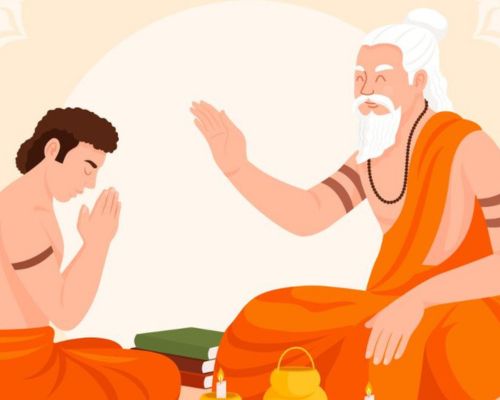
आचार्य-कुल में विद्या समाप्त करके विद्यास्नातक, व्रतस्नातक या विद्याव्रतस्नातक बनने के बाद घर लौटने के समय आचार्य-कुल या पितृ-कुल- इन दोनों में से किसी एक जगह जो संस्कार किया जाता है उसे समावर्तन, अर्थात् पितृ-कुल में वापस लौट आना कहा जाता है। पुरुष के लिये यह समय 24, 36या 48 वर्ष का हो सकता है।
जैसे उपनयन तथा वेदारम्भ का जोड़ा है, उपनयन के साथ ही वेदारम्भ संस्कार किया जाता है, वैसे ही समावर्तन संस्कार तथा विवाह संस्कार का जोड़ा है। समावर्त्तन का अर्थ है-घर लौटाना, परन्तु यह लौटना आचार्य-कुल से पितृ- कुल में होता है और पितृ-कुल में लौटने के बाद स्नातक के विवाह की तय्यारी होती है, इसलिये समावर्त्तन तथा विवाह संस्कार के कार्य कुछ मिले-जुले हैं। तभी संस्कारविधि में लिखा है- 'विवाह के स्थान दो हैं - एक आचार्य का घर, दूसरा अपनता घर। दोनों ठिकानों में से किसी एक ठिकाने आकर विवाह में लिखे प्रमाणे सब विधि करें।' इस दृष्टि से समावर्त्तन की विधि या आचार्य-कुल में हो सकती है या पितृ-कुल में हो सकती है, परन्तु क्योंकि आचार्य-कुल में होना ज्यादा शोभाजनक है, स्नातक का विद्या-ग्रहण का कार्य भी आचार्य-कुल में हुआ है, इसलिये यह सारी विधि आचार्य-कुल में ही की जाती है।
अनन्तर स्नातक घर चला आता है जहाँ माता-पिता, भाई-बहन, चाचा-मामा आदि उसका घर में स्वागत करते हैं। आचार्य के उपदेश के बाद आचार्य-कुल में जो छोटे-मोटे कार्य किये जाते हैं, उनका आचार्य-कुल की अबतक की नियम-मर्यादा पर विशेष प्रकाश पड़ता है। अबतक विद्यार्थी पर अनेक बन्धन थे-जूता मत पहनना, छाता मत लगाना, उस्तरे का इस्तेमाल मत करना, शीशा मत देखना- इस प्रकार के बीसियों बन्धन ब्रह्मचारी पर लगे हुए थे। अब वह तपस्या के इस जीवन को समाप्त कर ब्रह्मचर्य से गृहस्थ में प्रवेश करने वाला है, इसलिये आचार्य की आज्ञा से सब बन्धन शिथिल किये जाते हैं,
आचार्य-कुल में विद्या समाप्त करके विद्यास्नातक, व्रतस्नातक या विद्याव्रतस्नातक बनने के बाद घर लौटने के समय आचार्य-कुल या पितृ-कुल इन दोनों में से किसी एक जगह जो संस्कार किया जाता है उसे समावर्तन, अर्थात पितृ-कुल में वापस लौट आना कहा जाता है। पुरुष के लिये यह समय २४,३६ या ४८ वर्ष का हो सकता है।इस संस्कार के लिये विशेष सामान-मीठा भात, खीर, लड्डू या खिचड़ी में से कोई एक पदार्थ-स्थालीपाक; ८ घड़े पानी से भरे वेदी के उत्तर- भाग में रखें, उबटन, स्नान के बाद अनुलेपन के लिये चन्दन घिस कर रखें, दही तथा तिल, पुष्पमाला, धोती तथा पीताम्बर, पगड़ी, सुरमा, जूता, एक सुन्दर छड़ी, आचार्य के सत्कार के लिये मधुपर्क का सामान, पुष्पमाला, उत्तम वस्त्र, गौ आदि। उक्त सब सामान आचार्य के घर में संस्कार के एक दिन पहले जोड़ कर रखें। यज्ञ के समय आचार्य पूर्वाभिमुख बैठे।
After completing education in Acharya-Kul and becoming a Vidyasanataka, Vratasnataka or Vidyavratasnataka, at the time of returning home, the rites performed at either Acharya-Kula or Pitru-Kul - at either of these two places, is called Samavartan, i.e. returning back to Pitru-Kul. It is said. For men this time can be 24, 36 or 48 years.
Just as there is a pair of Upanayan and Vedarambh, Vedarambh Sanskar is performed along with Upanayan, similarly there is a pair of Samavartan Sanskar and Vivah Sanskar. Samavartan means returning home, but this return takes place from the Acharya clan to the ancestral clan and after returning to the ancestral clan, preparations are made for the graduate's marriage, hence the functions of Samavartan and marriage rituals are somewhat mixed. That is why it is written in the rituals - 'There are two places of marriage - one is Acharya's house, the other is our own house. Come to one of the two places and perform all the rituals as written in the marriage. From this point of view, the process of Samavartan can be done either in Acharya-Kul or in Pitru-Kul, but because it is more graceful to be in Acharya-Kul, the process of acquiring education of a graduate is also done in Acharya-Kul, hence All this method is done in the Acharya clan only.
Later the graduate comes home where his parents, brothers-sisters, uncles-uncles etc. welcome him home. The small tasks that are done in the Acharya clan after the teachings of the Acharya throw special light on the rules and regulations of the Acharya clan till now. Till now there were many restrictions on the student - do not wear shoes, do not carry an umbrella, do not use razor, do not look in the mirror - twenty such restrictions were imposed on the celibate. Now he is about to end this life of penance and enter the life of a householder with celibacy, hence with the permission of Acharya, all the bonds are relaxed,
After completing the education in Acharya-Kul and becoming a Vidyasnatak, Vratsnatak or Vidyavratsnatak, the ritual performed at either Acharya-Kul or Pitru-Kul at the time of returning home is called Samavartan, i.e. returning back to Pitru-Kul. goes. For a man this time can be 24, 36 or 48 years.Special items for this Sanskar - any one item from sweet rice, kheer, laddu or khichdi - Sthalaipak; Keep 8 pitchers filled with water in the north part of the altar, after boiling, after bathing, keep sandalwood rubbed for purification, curd and sesame seeds, garland of flowers, dhoti and pitambar, turban, surma, shoes, a beautiful stick, for the hospitality of the Acharya. For Madhupark's items, flower garlands, fine clothes, cow etc. Keep all the above mentioned items in the Acharya's house a day before the ceremony. At the time of Yagya, Acharya sat facing east.

विवाह के सम्बन्ध में दो दृष्टिकोण हैं। एक दृष्टि-कोण तो यह है कि विवाह स्त्री-पुरुष का एक ऐसा ठेका (Contract) है जिसमें स्त्री अपने ऊपर बालक की परवरिश की और पुरुष अपने ऊपर इन दोनों की भूख-प्यास-संरक्षा आदि की जिम्मेदारी लेता है। भूख-प्यास-संरक्षा आदि मनुष्य की आधारभूत जरूरियात हैं। एक-दूसरे की इन जरूरियात को पूरा करने के लिए स्त्री-पुरुष मानो एक प्रकार का सौदा करते हैं। ठेके के साथ ठेके के टूटने का भाव भी जुड़ा रहता है। अगर वे एक-दूसरे की जरूरियात को पूरी नहीं कर सकते, तो यह ठेका टूट सकता है, स्त्री-पुरुष विवाह-बन्धन से छूट सकते हैं। दूसरे लोग जो बच्चों की सुरक्षा में जरा-सा भी खतरा मोल लेना नहीं चाहते, उनका दृष्टिकोण यह है कि विवाह कोई ठेका नहीं, यह किन्हीं शर्तों पर नहीं किया जाता, विवाह तो एक 'धार्मिक- संस्कार' (Sacrament) है, यह टूट नहीं सकता, एक बार हो गया तो हो गया, इसे आजन्म निभाना होता है। विवाह के विषय में हमारे समाज में सनातन काल से यही धारणा चली आ रही है। यह जन्म-जन्मान्तर का सम्बन्ध है। इसे तो हर हालत में निभाना ही निभाना है। जो लोग विवाह को धार्मिक सम्बन्ध नहीं मानते वे तो 'सिविल मैरेज' कर लेते हैं। रजिस्ट्रार के यहाँ अपना विवाह रजिस्टर्ड करा लेते हैं। उन्हें किसी धार्मिक-संस्कार की जरुरत नहीं पड़ती, जो लोग विवाह को धार्मिक-संस्कार मानते हैं, वे विवाह को रजिस्टर्ड नहीं कराते, वे धार्मिक संस्कार की विधि द्वारा विवाह करते हैं। विवाह एक धार्मिक-संस्कार (Sacrament) है। 'ठेका' (Contract) नहीं है विवाह एक ऐसा पवित्र बंधन है जिस मे दो आत्माओं को अपने - अपने अस्तित्व को भूलाकर एक होना होता है। विवाह का शाब्दिक अर्थ होता है। वि = अच्छे प्रकार से वह = वहन करना अर्थात गृहस्थ जीवन के जिम्मेदारियों को ठीक प्रकार से दोनों मिल कर निभाये व वहन करें
विवाह, एक पुराना संस्कृतिक और सामाजिक संस्कृति में महत्वपूर्ण घटना है जो दो व्यक्तियों को एक दूसरे से बंधनित करती है। यह संबंध न केवल दो व्यक्तियों के बीच बनता है, बल्कि यह पूरे समाज को एकीकृत करने वाला एक महत्वपूर्ण सामाजिक घटना भी है। विवाह हिन्दू धर्म में सात विवादों के साथ अभिवादित किया जाता है, जिसमें विवाहिता और विवाही एक दूसरे के साथ अनेक प्रतिबद्धियों को स्वीकार करते हैं।
रिश्ता देखना (बच्चों का देखभाल) परिवारों में यह समय होता है जब विभिन्न रिश्तों को देखा जाता है ताकि एक अच्छा जीवनसाथी चयन किया जा सके।
मिलन समारोह (बच्चों का मिलना) जब दो परिवार रिश्ता बनाने के लिए संगठित होते हैं, तो एक मिलन समारोह हो सकता है जिसमें दो जीवनसाथी आपस में मिल सकते हैं और एक दूसरे को समझ सकते हैं।
टिलक और सागर (रोका रस्म) इस समय में, विवाह के लिए सहमति जताने के रूप में विवाही पुरुष को टिलक और सागर रस्म करना हो सकता है। इससे समझ में आता है कि यह रिश्ता अब सार्थक हो गया है और विवाह होने वाला है।
महंदी और संगीत समारोह प्रियजनों और दोनों के परिवारों के साथ महंदी और संगीत समारोह हो सकता है, जो मजेदार और आनंदमय माहौल में होता है।
There are two viewpoints regarding marriage. One point of view is that marriage is a contract between a man and a woman in which the woman takes the responsibility of raising the child and the man takes the responsibility of hunger, thirst, protection etc. of both of them. Hunger, thirst, safety etc. are the basic needs of humans. To fulfill these needs of each other, it seems as if men and women make a kind of deal. The feeling of breaking the contract is also associated with the contract. If they cannot fulfill each other's needs, then this contract can be broken and man and woman can be freed from the bond of marriage. Others, who do not want to take even the slightest risk in the safety of their children, hold the view that marriage is not a contract, it is not done on any terms, marriage is a 'sacrament', it cannot be broken. Can't, once it's done it's done, it has to be maintained throughout life. This belief regarding marriage has been prevalent in our society since ancient times. This is a relation of birth after birth. It has to be followed in every situation. Those who do not consider marriage as a religious relationship, they do 'civil marriage'. Get your marriage registered at the registrar. They do not need any religious rites, those who consider marriage as a religious rite, they do not get the marriage registered, they get married through the method of religious rites. Marriage is a religious sacrament. Marriage is not a 'contract', it is such a sacred bond in which two souls have to forget their separate existences and become one. Marriage has a literal meaning. Vi = in a good way That = to bear i.e. both should jointly fulfill and bear the responsibilities of family life properly.
Marriage is an ancient cultural and social event that binds two people to each other. This relationship is not only formed between two individuals, but it is also an important social phenomenon that integrates the entire society. Marriage is celebrated in Hinduism with seven vows, in which the bride and groom accept a number of commitments to each other.
Relationship Viewing (Child Care) This is the time in families when various relationships are looked at so that a good life partner can be selected.
Meeting Ceremony (Meeting of Children) When two families come together to form a relationship, a meeting ceremony can take place in which the two spouses can meet and understand each other.
Tilak and Sagar (Roka ritual) At this time, the married man may have to perform the Tilak and Sagar ritual as a sign of consent to the marriage. This makes it clear that this relationship has now become meaningful and marriage is about to happen.
Mehndi and Sangeet Ceremony Mehndi and Sangeet ceremony can be done with loved ones and families of both, in a fun and joyful atmosphere.
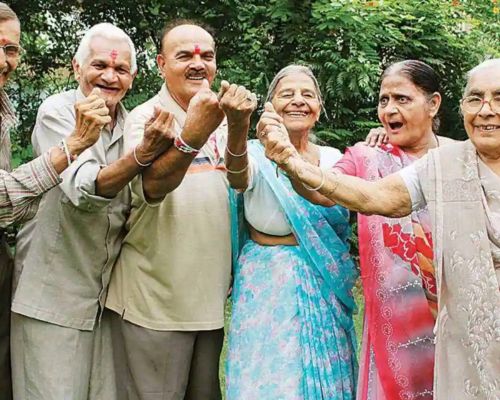
बम्बई का शहर है, सामने लम्बी सड़क है लोगों की भारी भीड़ उमड़ी चली जा रही है, कन्थे-से-कन्धा टकराता है, कुछ आ रहे हैं, कुछ जा रहे हैं, स्त्री-पुरुष, जा रही है, कुनो सभी हैं। किसी को खड़ा करके पूछिये, क्यों भाई, क्या हुआ, इस तरह बेतहाशा किधर भागे जा रहे हो, तो वह बिना रुके, चलता-चलता जो कह जाता है उसका मतलब होता है, रोटी का फिक्र, आगे-पीछे का फिक्र नहीं, आज का और अब का फिक्र-इसी फिक्र में, वह क्या और दूसरे क्या, सभी भागे जा रहे हैं। अब हरिद्वार का नजारा देखिये। गंगा का तट है, हर की पैड़ी, सैंकड़ों साधु भगवा रमाये इधर-उधर टहल रहे हैं। कुछ मण्डली लगाये धर्म को चर्चा कर रहे है। किसी मण्डली में जाकर पूछिये, महात्मा लोगो ! आपको मालूम है, आज संसार को क्या दशा है, रोटी का प्रश्न सबको व्याकुल कर रहा है, इसी समस्या को हल करने में प्रत्येक व्यक्ति जुटा हुआ है, तो वे क्या उत्तर देते हैं ? महात्माओं की मण्डली कहती है, हाँ हमें मालूम है, परन्तु हमें इससे क्या, हम तो आत्मा के चिन्तन में लगे हुए हैं, आज की और अब की नहीं, हम आगे और पीछे की समस्या को हल करने में जुटे हैं। संसार अनित्य है, घर-बार, बन्धु-बान्धव, स्त्री- पुत्र सब अनित्य हैं, इन्हें छोड़ हम नित्य आत्मा-परमात्मा की खोज में लगे हुए हैं।जीवन के विषय में यही मोटे-मोटे दो विचार हैं। एक वर्तमान में जीना चाहता है, उसे भविष्यत् का विचार नहीं, दूसरा भविष्यत् के लिए जीना चाहता है, उसे वर्तमान का ख्याल नहीं। जीवन के विषय में ये दो दृष्टियाँ, जहाँ भी जीवन पर विचार हुआ, उत्पन्न हो गईं। प्राचीन ग्रीस के विचारकों में वर्तमान में जीने वाले 'एपीक्यूरिअन' (Epicureans) कहलाते थे, भविष्यत् के लिए जीनेवाले (Sto- ics) कहलाते थे। एपीक्यूरिअन लोगों के विषय में कहा जाता है कि वे जीवन का सम्पूर्ण आनन्द, जल्दी-से-जल्दी जितना हो सके उतना, आज और अभी लूट लेना चाहते थे, आगे क्या होता है, क्या नहीं होता- इसका उन्हें कोई भरोसा नहीं था। स्टोइक लोग तपस्वियों का जीवन व्यतीत करते थे, आज का ख्याल न करके, आगे जो होगा उस दृष्टि से जीवन का कार्यक्रम बनाते थे। इनमें से एक भोग-मार्ग था, दूसरा त्याग-मार्ग था। संसार के इतिहास में इन्हीं दो मार्गों में से किसी एक मार्ग पर मानव-समाज चलता आ रहा है। कुछ लोग भोग-मार्ग के उपासक रहे हैं, वर्तमान में डूबे रहे हैं, कुछ लोग त्याग-मार्ग के उपासक रहे हैं, भविष्यत् की चिन्ता में
It is the city of Bombay, there is a long road in front, a huge crowd of people is moving, bumping shoulder to shoulder, some are coming, some are going, men and women, everyone is going, everyone is there. If you make someone stand up and ask, why brother, what happened, where are you running so wildly like this, then whatever he says while walking without stopping, it means that he is worried about the food, not worried about the front and back, today. Worrying about the here and now - everyone is running away in this worry, what is that and what is the other.
Now see the view of Haridwar. There is the bank of Ganga, Har Ki Paadi, hundreds of Sadhu Bhagwa Ramaye are strolling here and there. Some congregations are organized and discussing religion. Go to any group and ask, Mahatma people! You know, what is the condition of the world today, the question of bread is troubling everyone, every person is busy in solving this problem, then what do they answer? The group of Mahatmas say, yes we know, but what do we have to do with it, we are engaged in the contemplation of the soul, not of today and now, we are engaged in solving the problems of the future and the past. The world is impermanent, home and family, friends and relatives, wife and son are all impermanent, leaving these aside we are always engaged in the search of the soul and God.These are two broad thoughts about life. One wants to live in the present and does not care about the future, the other wants to live for the future and does not care about the present. These two views on life arose wherever life was discussed. Among the thinkers of ancient Greece, those who lived in the present were called 'Epicureans', those who lived for the future were called 'Sto-ics'. It is said about the Epicureans that they wanted to capture all the joy of life, as quickly as possible, in the here and now, they had no confidence in what would happen next, what would not happen. Stoics used to live the life of ascetics, without thinking about today, they used to plan their life keeping in mind what will happen next. One of these was the path of enjoyment, the other was the path of sacrifice. Throughout the history of the world, human society has been following one of these two paths. Some people have been worshipers of the path of enjoyment, immersed in the present, some people have been worshipers of the path of renunciation, worried about the future.
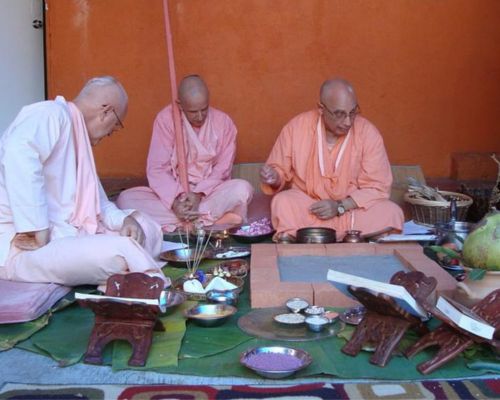
वैदिक-संस्कृति को जन्म देनेवाले ऋषियों ने जीवन को यात्रा कहा था, और इसे चार पड़ावों में बाँटा था। चौथा पड़ाव संन्यास-आश्रम था। वे खुली हवा में रहने को इतना पसन्द करते थे कि उनकी रूपरेखा के अनुसार जीवन का तीन- चौथाई हिस्सा खुली हवा में बीत जाता था। ब्रह्मचारी जंगल में रहते थे, गृहस्थी शहरों में रहते थे, परन्तु वानप्रस्थ और संन्यास फिर खुली हवा के आश्रम थे। इस प्रकार जीवन के सबसे अधिक भाग को खुले मैदानों और जंगलों में बिताने के कारण उस समय आयु की लम्बाई आजकल से बहुत अधिक थी। सौ बरस जीना - 'जीवेम शरदः शतम्'- यह प्रत्येक नर-नारी की एक स्वाभाविक आकांक्षा थी।आज संन्यास-आश्रम का अभिप्राय यह समझा जाता है कि मनुष्य सब काम छोड़कर बैठ जाय। हमारा देश ऐसे संन्यासियों से भरा पड़ा है जो कुछ नहीं करते। वे समझते हैं, अगर वे कुछ करेंगे तो संन्यासी ही नहीं रहेंगे। आज हम कुछ न क.ने का नाम संन्यास समझते हैं, परन्तु आश्रम-व्यवस्था में जिस संन्यास की कल्पना की गई है वह ऐसा नहीं है। संन्यास चारों आश्रमों की श्रृंखला में एक कड़ी है, जीवन-यात्रा में आखिरी मंजिल है, अन्तिम पड़ाव है। जिस भाव का विकास पहले आश्रमों में किया जाता है, उसी की चरम सीमा संन्यास में होती है, जिस उद्देश्य को लेकर पहले आश्रम चलते हैं, वह उद्देश्य धीरे-धीरे पूरा होता हुआ संन्यास में पूर्णरूप से सिद्ध हो जाता है। संन्यास स्वतन्त्र आश्रम नहीं है, पहले तीन आश्रमों के साथ जुड़ा हुआ है, और जो भावना पहले तीन आश्रमों में काम करती है वही संन्यास में अपनी पूर्णता पर पहुँच जाती है। हम यह देख चुके हैं कि पहले तीन आश्रमों में क्या विचार काम कर रहे हैं।
The sages who gave birth to the Vedic culture had called life a journey and had divided it into four stages. The fourth stop was Sannyasa Ashram. He liked living in the open air so much that according to his outline, three-fourth of his life was spent in the open air. Brahmacharis lived in forests, householders lived in cities, but Vanaprastha and Sannyasa were open-air ashrams. Thus, due to spending most of the life in open fields and forests, the length of life at that time was much longer than today. To live for a hundred years - 'Jeevem Sharadah Shatam' - this was a natural aspiration of every man and woman.Today, the meaning of Sannyasa Ashram is understood to be that a person should leave all work and sit down. Our country is full of such ascetics who do nothing. They think that if they do anything then they will cease to be sannyasis. Today we consider doing something as Sannyasa, but the Sannyasa as envisioned in the Ashram system is not like that. Sannyasa is a link in the chain of four ashrams, it is the last destination in the journey of life, the last stop. The feeling which is first developed in the Ashrams, reaches its zenith in Sannyasa, the purpose with which the Ashrams are run in the first place, gets fulfilled gradually and is completely accomplished in Sannyasa. Sannyasa is not an independent Ashrama, it is connected with the first three Ashramas, and the same spirit which works in the first three Ashramas reaches its perfection in Sannyasa. We have seen what ideas are at work in the first three Ashrams.
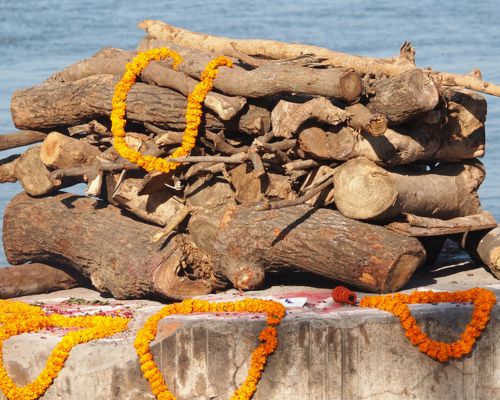
यह कल्पना कि मरने के बाद आत्मा 'यमलोक' को जाता है-एक मिथ्या- कल्पना है। इस कल्पना का आधार गरुड़ पुराण आदि में यमलोक का वर्णन है, परन्तु यह बात वेदों के 'यम' शब्द को न समझने के कारण उत्पन्न हुई है। वेदों में 'यम' शब्द का प्रयोग अनेक पदार्थों के लिए हुआ है, जिसे न समझकर 'यम' का अर्थ 'यमलोक' कर दिया गया है।
मरने के बाद क्या आत्मा सर्वथा शरीर से मुक्त हो जाता है ? मरने के बाद यह स्थूल शरीर तो छूट जाता है, परन्तु क्या उसका कोई सूक्ष्म-शरीर बना रहता है? जो लोग पुनर्जन्म मानते हैं, उनका पुनर्जन्म मानने का मुख्य-कारण कर्म का सिद्धान्त है। कर्म कहाँ रहते हैं? कर्म का आधार तो शरीर है, शरीर में भी हमारा मस्तिष्क है। मस्तिष्क में कर्म के संस्कार जमा रहते हैं। परन्तु मर जाने पर जब मस्तिष्क ही समाप्त हो जाता है, तब कर्मों के संस्कार किस आधार पर विद्यमान रहेंगे? शरीर के भस्म हो जाने पर मस्तिष्क भी भस्मित हो गया, मस्तिष्क भस्म हो गया, तो कर्मों के संस्कार भी भस्म हो गये, कर्मों के संस्कार ही न रहे, तो पुनर्जन्म का आधार क्या रहा ?
इसी शङ्का की निवृत्ति के लिए भारतीय विचारकों ने सूक्ष्म-शरीर की कल्पना की है। सूक्ष्म-शरीर को लिङ्ग-शरीर, कारण-शरीर, आतिवाहिक-शरीर-इन भिन्न- भिन्न नामों से स्मरण किया जाता है। यह शरीर सूक्ष्म भौतिक-तत्त्वों से बना है, इतने सूक्ष्म कि इसे भौतिक होते हुए भी अभौतिक कहा जाता है, और क्योंकि पञ्चेन्द्रियों के भौतिक शरीर के नष्ट हो जाने पर भी यह नष्ट नहीं होता, इसलिए हमारे कर्मों के संस्कार इस सूक्ष्म शरीर में बने रहते हैं, जो अगले जन्म में अपना फल लाते हैं। सत्यार्थप्रकाश के नवम समुल्लास में ऋषि दयानन्द लिखते हैं कि शरीर तीन हैं- एक स्थूल जो दीखता है, दूसरा सूक्ष्म-शरीर जिसके दो भेद हैं- भौतिक तथा अभौतिक। यह अभौतिक शरीर मुक्ति में भी रहता है, इसी से जीव मुक्ति में सुख भोगता है।
कहने का अभिप्राय यह है कि शरीर के मर जाने पर भी आत्मा के साथ एक अन्य शरीर बना रहता है जो हमारे कर्मों का आधार है, अन्यथा आत्मा के भीतर तो कोई वस्तु नहीं, जिसमें कर्म संगृहीत रूप में बने रहें। आत्मा के इस सूक्ष्म-शरीर के सम्बन्ध में जो भारतीय दार्शनिक विचार हैं उसकी वर्तमान खोजों से भी पुष्टि हुई है।
संस्कृत में मृत्यु के लिए शब्द है 'पंचत्वम् गतः'। शरीर पांच तत्वों से बना है - पृथ्वी, जल, अग्नि, वायु और आकाश; इसलिए, मृत्यु के बाद, वैदिक विधि शरीर के इन पांच तत्वों को जितनी जल्दी हो सके उनके मूल स्वरूप में कम करना है। पृथ्वी का मतलब जमीन या मिट्टी नहीं है, पानी का मतलब पानी नहीं है, हवा का मतलब बहती हुई हवा नहीं है। ये उनके भौतिक रूप हैं. इन रूपों से भी अधिक सूक्ष्म इन पाँच भूतों का रूप है। ये भौतिक रूप दृश्यमान हैं, वह रूप अदृश्य है। मृत शरीर को शीघ्रता से अदृश्य, सूक्ष्म तत्वों में परिवर्तित करने का एकमात्र साधन 'अग्नि' ही है। अन्य सभी साधनों में समय लगता है, अग्नि एक ऐसा साधन है जो इस कार्य को शीघ्र कर देता है। कब्र में दफनाने के बाद किसी शव को मिट्टी में बदलने में कई महीने लग जाते हैं। ऐसा लगता है कि जब शव को पानी में फेंक दिया जाता है, तो वह मछलियों के पेट में सड़ जाता है। और अपने मूल स्वरूप में वापस आने में भी काफी समय लगता है। यदि खुला छोड़ दिया जाए तो महीनों लग जाते हैं, क्योंकि हड्डियाँ शेष रह जाती हैं - अग्नि द्वारा दाह संस्कार ही एकमात्र ऐसा साधन है जिसके द्वारा मृत शरीर के सभी तत्व एक घंटे के भीतर अपने मूल स्थान पर पहुँच जाते हैं। अंतिम संस्कार के लिए प्रत्येक आवश्यक वस्तु और सामग्री कुशलतापूर्वक होती है
The word for death in Sanskrit is 'Panchatvam Gatah'. The body is made up of five elements – earth, water, fire, air and sky; therefore, after death, the Vedic method is to reduce these five elements of the body to their original form as quickly as possible. Earth does not mean land or soil, water does not mean water, air does not mean flowing air. These are their physical forms. Even more subtle than these forms is the form of these five ghosts. These physical forms are visible, that form is invisible. 'Fire' is the only means to quickly transform the dead body into invisible, subtle elements. All other means take time, fire is such a means which makes this work quick. It takes months for a dead body to turn into dust after being buried in a grave.It seems that when the dead body is thrown into water, it rots in the stomach of fishes.and takes considerable time to return to its original form, even months if left open It seems, because the bones remain - cremation by fire is the only such It is a means by which all the elements of the dead body reach their origin within an hour.Every necessary item and material for the last rites is efficiently arranged by your Arya Samaj Pandit ji
Book Online The Best Arya Samaj Pandit Ji And Arya Samaj Mandir nearest You. For Solah Sanskar vidhi, Grih pravesh, Marriage Puja, one day marriage Registration, Love Marriage, Last Rites, Last Journey, And,Cremation Grounds.
